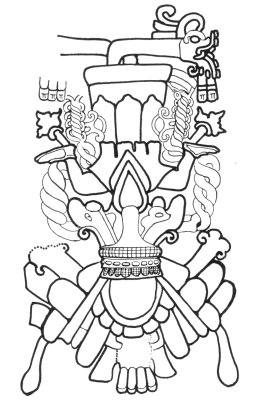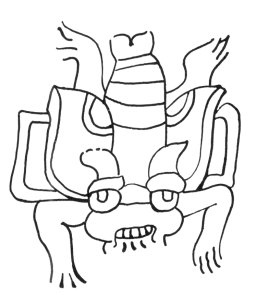

/
| p. 1 C |
FIG. 1 a--Ah Muzencab, the Maya bee god. (After Lothrop.) 7 b, A bee.
(Codex Tro-Cortesianus, p. 83.)
The lord of the people of the south is the first of the men of the Noh 1 family. Ix-Kan-tacay 2 is the name of the first of the men of the Puch family. They guard nine rivers; they guard nine mountains 3
The red flint stone is the stone of the red Mucencab. 4 The red ceiba tree of abundance 5 is his arbor 6 which is set in the east. The red bullet-tree 7 is their tree. The red zapote . . . The red-vine 8 . . . Reddish are their yellow turkeys. Red toasted <corn> is their corn.
The white flint stone is their stone in the north. The white ceiba tree of abundance is the arbor of the white Mucencab. White-breasted are their turkeys. White Lima-beans are their Lima-beans. White corn is their corn.
The black flint stone is their stone in the west. The black ceiba tree of abundance is their arbor. Black speckled corn is their corn. Black tipped camotes are their camotes. Black wild pigeons are their turkeys. Black akab-chan 9 is their green corn. Black beans are their beans. Black Lima-beans are their Lima-beans.
The yellow flint stone is the stone of the south. The ceiba tree of abundance, the yellow ceiba tree of abundance, is their arbor. The yellow bullet-tree is their tree. <Colored like> the yellow bullet-tree are their camotes. <Colored like> the yellow bullet-tree are the wild pigeons which are their turkeys. Yellow green corn is their green corn. Yellow-backed are their beans . . . /
| p. 2 C |
[paragraph continues] 11 Ahau was the katun when they carried <burdens> on their backs. Then the land-surveyor first came; 1 this was Ah Ppizte 2 who measured the leagues. Then there came the chacté shrub 3 for marking the leagues with their walking sticks. Then he came<to> Uac-hab-nal} 4 to pull the weeds along the leagues, when Mizcit Ahau came to sweep clean the leagues, when the land-surveyor came. These were long leagues that he measured.
Then a spokesman was established at the head of the mat.
Ix Noh Uc presides to the east. Ox Tocoy-moo presides to the east. Ox Pauah Ek presides to the east. Ah Miz presides to the east.
Batun presides to the north. Ah Puch presides to the north. Balam-na presides to the north. Ake presides to the north.
Iban presides to the west. Ah Chab presides to the west. Ah Tucuch preside to the west.
Ah Yamas presides to the south. Ah Puch presides to the south. Cauich presides to the south. Ah Couoh presides to the south. Ah Puc presides to the south. 5
The red wild bees 6 are in the east. A large red blossom is their cup. The red Plumeria is their flower.
The white wild bees are in the north. The white pach¢a 7 is their flower. A large white blossom is their cup.
The black wild bees are in the west. The black laurel flower 8 is their flower. A large black blossom is their cup.
The yellow wild bees are in the south. A large yellow blossom 9 is their cup . . . is their flower./
| p. 3 C |
Then they swarmed at ¢ecuzamil 1 in great numbers among the magueys 2 of the land, the calabash trees of the land, the ceiba trees of the land and the chulul trees of the land. 3 Kin Pauahtun 4 was their priest. He commanded the numerous army which guarded Ah Hulneb 5 at Tantun in Cozumel, <also> Ah Yax-ac, 6 Chinab, 7 and Kinich Kakmo. 8
63:1 One folio is missing from the beginning of the book.
63:2 Martinez H. translates this sentence: "the first figure or idol is that of Ah Canul" (Martinez. H. 1921).
63:3 Maya, uaxim, Leucæna glauca Benth. Botanical identifications will be found in Standley 1930 and Roys 1931.
63:4 Maya, chacah, Bursera simaruba Sarg. Spanish palo mulato.
63:5 Maya, pazel, a temporary shelter consisting of a single-pitched roof and open at one side, used for camping out.
63:6 Yax-um, literally the green bird, the quetzal. Um or un is an obsolete word for bird, surviving only in compounds of names of birds, such as pichum, ucum, yuyum, chahum, etc. Cf. Quiche, Rax-on, quetzal, and um, a certain black bird. (Ximenez, Tesoro, etc.)
63:7 Copy of the stucco figure at Tulum known as the Diving god. (Lothrop 1924, pl. 23.) Besides its obvious resemblance to the insect in the Codex Tro-Cortesianus identified by Tozzer and Allen as a bee, it seems possible to recognize the pulvilli, ungues and metanotum, while the wings somewhat suggest the battered membranes of a bee's wings. A similar Diving God has been found at Cobá, where the Muzencabob are still believed to dwell (Thompson, Pollock, Charlot 1932, p. 84; Redfield letter).
64:1 Noh, a common family name, resembles nohol, which means south.
64:2 Lit. yellow tacay, the Mexican large-billed tyrant. Cf. Roys 1931, p. 339.
64:3 Maya, Bolonppel-uitz, probably a place-name in the south. The name may survive in that of Salinas de los Nueve Cerros on the Chixoy River.
64:4 This name is spelled Muzencab in the Tizimin manuscript, so Mucencab is probably intended for Muçencab. Cab means hive or honey. As shown in Appendix A, the bees are closely connected with the Bacabs and the four world-quarters, and Dr. Redfield finds the Muzencabs invoked in the u hanli cab ceremony which is propitiatory of the gods of the bees. One native priest explained that "the Mulzencab-ob were a class of supernatural bees dwelling at Cobá. They report to Nohyumcab (Great-lord-of-the-hive), their superior, everything that happens in the apiary." Another native priest, or h-men, stated that the Nohyumcab and the Ah Muzencab were two gods in the form of large bees who governed all the bees (Letter from Dr. Robert Redfield).
64:5 Maya, imix yaxche. Imix is one of the Maya day-names, and the yaxche is the ceiba tree, the green tree and the first tree of the world. Seler shows that Imix has much the same significance as Cipactli, the corresponding Aztec day-name. It is the symbol of fertility and abundance, and among the Cakchiquels it is closely associated with the ceiba tree (Seler 1902, p. 499). Beyer 1931, p. 204.
64:6 This arbor may correspond to the arch of leaves and branches set up in connection with the New Year's ceremonies (Landa 1929, p. 20).
64:7 Maya, pucté, Bucida buceras L.
64:8 Maya, chac-ak, the name of an unidentified vine, used medicinally.
64:9 Akab-chan is probably a dark variety of maize (Martinez letter). The Maya have corn of various colors, and there is a large vocabulary relating to maize (Standley 1930, p. 211).
65:1 This appears to the translator to be a legend of the occupation of the country in ancient times. People came in bearing their household goods on their backs, as we know they had no beasts of burden. Then they were supposed to have surveyed and divided the land, after which they laid out the roads, cleared and cleaned them.
65:2 A Maya pun: a man who measures or a man of the Ppizte family.
65:3 Probably a shrubby form of the chacté, or brazil tree is meant (Cæsalpinia platyoba Wats.). It is a well-known dye wood, and Landa tells us that the Maya made staffs of it.
65:4 It seems likely that Uuc-yab-nal is intended. This is a place-name associated with "the mouth of the well" in the prophecy for Katun 4 Ahau on page 133. In another prophecy for Katun 4 Ahau on page 161 the name Chichen Itzá is substituted for Uuc-yab-nal, so it is possible that the latter was the ancient name for Chichen Itzá before the Itzá came and named it Chichen Itzá, "the mouth of the well of the Itzá."
65:5 Of the above names Uc, Batun, Balam, Ake, Cauich, Couoh and Puc are well known family names in Yucatan. Ah Puch is one of the names of the Maya death-god (Morley 1915, p. 17). Tucuch and Yiban Can are two of the Lords of the thirteen katuns (Morley 1920, p. 472, and Chilam Balam of Kaua, pp. 167 and 189). Ah Yamaz may be intended for Ah Yamazi who is mentioned on page 71. Ah Chab is the Maya name of the three-toed ant-eater.
65:6 Here the word for wild bees, ix chuuahcab-ob, has the feminine prefix. In the Motul Dictionary it is given as ah chuahcab with the masculine prefix.
65:7 There is little doubt that here the pah¢a is meant, which has been identified as Commelina elegans H. B. K. Here, however, the closely related Callisia repens L. with its white flowers may be intended.
65:8 The Ix-laul, called laurel in Spanish, is Stemmadenia insignis Miers, the flowers of which are white, not black.
65:9 Kan-lol, literally a large yellow blossom, also the name of Tecoma stans H. B. K.
66:1 ¢ecuzamil means Little Cozumel and may refer either to the Island itself or some place on the mainland of the east coast of Yucatan. Oy-cib was another name for Cozumel (Motul), and cib means beeswax.
66:2 Maya, u ciil cab; it could also mean the sweet things of the land.
66:3 The chulul has been identified as Apoplanesia paniculata Presl.
66:4 Probably Kan Pauahtun, the wind-god of the south, is intended. Cf. Appendix A.
66:5 Ah Hulneb, the Archer, was one of the principal deities of Cozumel which was a center of pilgrimage not only from every part of Yucatan but from Tabasco as well. Cf. Cogolludo, Book 4, Chap. 8.
66:6 Ah Yax-ac. Yax means green or first. Ac could mean turtle, dwarf, boar-peccary or a certain tall grass.
66:7 Chinab means the distance from the tip of the forefinger to that of the thumb. Ah ¢un Chinab was the name of one of the nobles who accompanied the embassy of Ah Mochan Xiu to Montejo.
66:8 Kinich Kakmo means sun-eyed fire macaw. He was one of the founders of Izamal and was afterwards deified (Relaciones de Yucatan, I, p. 269). His shrine was visited by sufferers from pestilence, whom he cured. It is of interest to note that yellow fever patients are still given the ashes of a red parrot's feathers as a remedy (Roys 1931, p. 63).